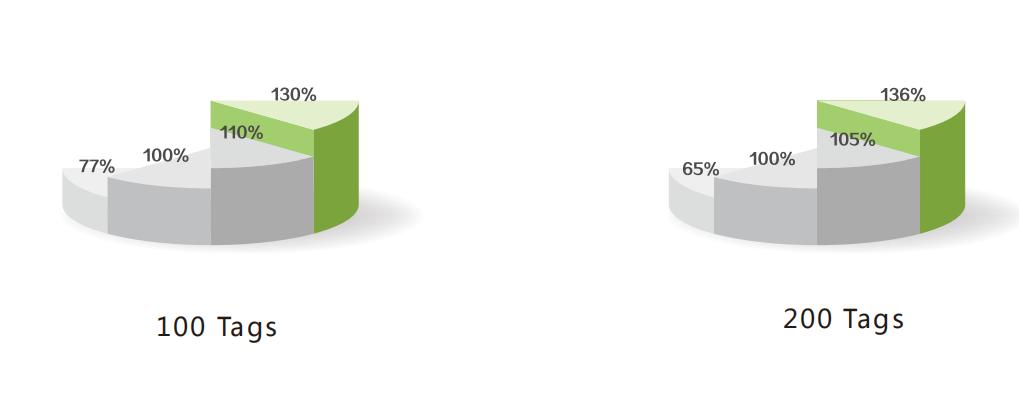Functions
Applications

Key Features
| Feature |
Descriptions
|
|
Impinj E710 Built-in |
Impinj E710 chip as RF transceiver |
|
Anti-collision Algorithm |
Unique I - Search multi-tag identification algorithm providing the highest efficiency. |
|
Optimized Algorithm for Tags with Small Volume |
Optimized applications for small volume with better tags respond time. |
|
Dual CPU Architecture |
Main CPU: tag inventory; Assistant CPU: data management. Tag inventory and data transfer are parallel and simultaneous. |
|
Fast 4-Antenna Switch Inventory |
Every antenna’s inventory duration is configurable( Minimum Duration: 30 ms). Polling from ANT 1 to ANT 4. |
|
Two Modes for Inventory |
Buffer mode and Real-time mode. Tags will be stored as buffer under buffer mode. Tags will send data under real-time mode. This mode allows user to get tag data instantly. |
|
Hardware System Halt Detection |
Hardware CPU status surveillance. Run for 24hours X 365 days without system halt. |
|
PA Health Surveillance |
PA status surveillance. Make sure PA never works under saturated state. Protected it for long term operation. |
|
18000-6B/6C Full Compatible |
It can be switched rapidly between 18000-6B and 18000-6C tag.
|
| 18000-6B Large Data Read/Write |
Read 216 bytes in one time taking less than 500ms. Write 216 bytes in one time taking less than 3.5 seconds. It can read/write data with different lengths. |
|
Antenna Connection Detection |
Detect antenna connection. Protective for RF receiver. It can be canceled with command. |
| Temperature Sensor | Multi-point surveillance for accurate operating system temperature. |
| Power Output Correction |
Dual modules making sure output power can be fine adjusted. Dual modules working and keeping correction unless they are both damaged. |
| Excellent Cooling Design |
Heat dissipation and large cooling surface design. Thermal coupling interfaces using high-thermal conductivity solid materials which ensure stable performance under high temperature. |
Electrical Parameters
| Electrical Parameters | |
| Dimension |
240(L)*180(W)*28(H)mm |
|
Weight |
1.2kg |
|
Body Material |
Die-cast aluminum |
|
Input Voltage |
DC 12V ~ 18V |
|
Standby Mode Current |
<80mA |
|
Sleep Mode Current |
<100uA |
|
Max Operating Current |
700mA +/-5% @ DC 12V Input |
|
Operating Temperature |
- 20 °C ~ + 85 °C |
|
Storage Temperature |
- 20 °C ~ + 85 °C |
|
Humidity |
5%RH - 95%RH (non -condensing)
|
| Interface Protocol | EPC global UHF Class 1 Gen 2 / ISO 18000-6C / ISO 18000-6B |
|
Spectrum Range |
902MHz – 928MHz,865MHz – 868MHz, other is optional |
| Supported Regions |
US, Canada and other regions following U.S. FCC Europe and other regions following ETSI EN 302 208 Mainland China, Taiwan, Korea, Malaysia |
| Output Power |
0 – 33dBm |
| RF Connector | TNC/RP-TNC |
| Output Power Precision | +/- 1dB |
|
Output Power Flatness |
+/- 0.2dB
|
| Receive Sensitivity |
< -85 dBm
|
| Peak Inventory Speed | >700 tags/sec |
|
Tag Buffer Capacity |
1000 tags @ 96 bit EPC |
| Tag RSSI | Supported |
|
Antenna Detector |
Supported |
| HAmbient Temp Monitor |
Supported
|
| Working Mode |
Single/DRM
|
| HHost Communication |
RS-232 or TCP/IP
|
| GPIO |
2 input optical coupling & 2 output coupling
|
| Baud Rate |
115200 bps/38400bps
|
| Heat Dissipation |
Air cooling
|

Notes
1.) The test is on same hardware platform in real applications (Taking Impinj dynamic Q algorithm as the reference which is marked with 100%).
2.) The chart shows the comparison for the first round inventory performance.
3.) It is tested on the same hardware platform.
| Algorithm |
Description |
|
Standard fixed Q algorithm |
• Standard 18000-6C algorithm. • The performance is reduced significantly when tag quantity gets larger. • The efficiency is not high when tag quantity is small. |
|
Impinj dynamic Q algorithm |
• The algorithm of Impinj. • It has a good efficiency for various tag quantities. • It sacrifices some performance for the sake of compatibility |
|
I–Search dynamic Q algorithm V1.0 |
• Based on Impinj dynamic Q algorithm. • The performance is optimized. • It’s the algorithm for firmware version 6.6 or below. |
|
I–Search dynamic Q algorithm V2.0 |
• Based on Impinj dynamic Q algorithm. • It’s a brand new data structure, the performance of which is significantly improved for firmware version 6.7 or above. • The improvement of performance can be easily sensed after the first round of inventory especially when the tag volume increases. |
Our Services
Wondering if our RFID device can work for you? Finding out is simple.
We are accepting your sample materials to run through our RSTC Lab for free testing and get the result. (You just need provide test sample)
We supply customers with better product, quicker response, more value added expertise service.
We provide personalized customization services, such as logo, software and hardware customization etc.


